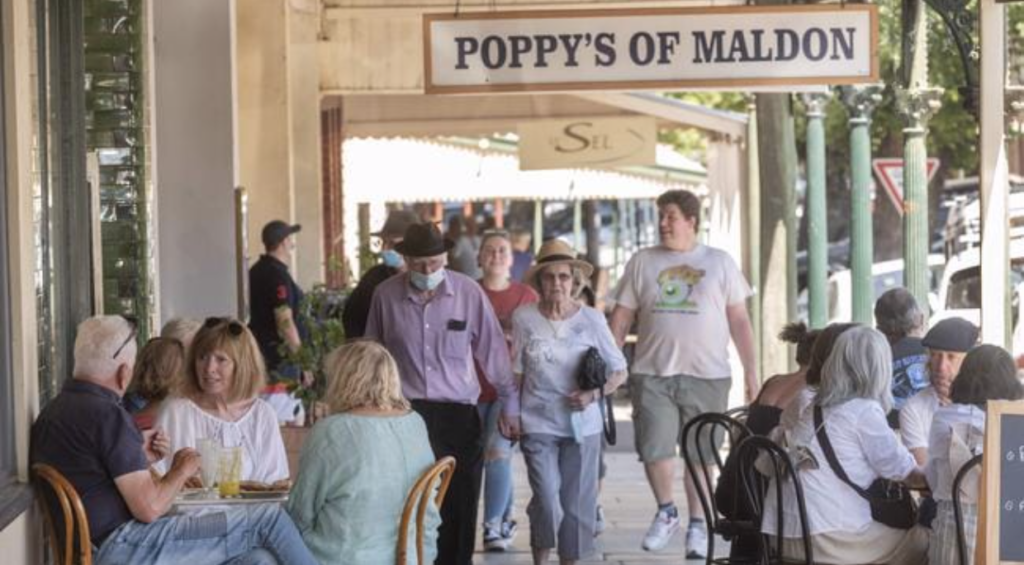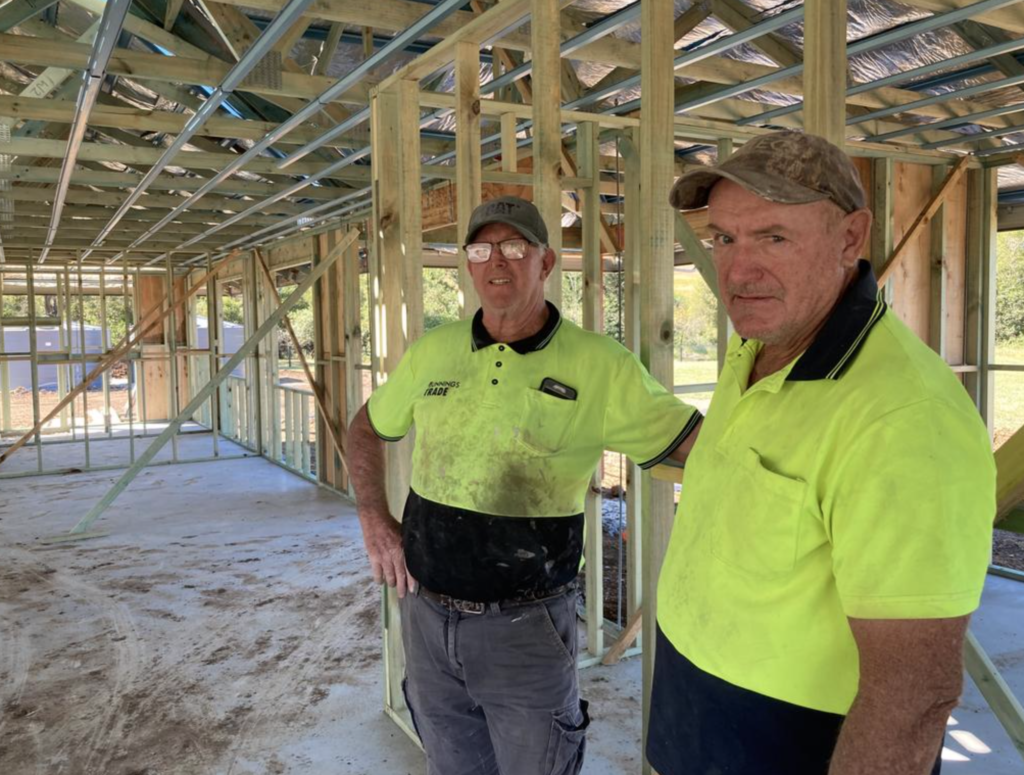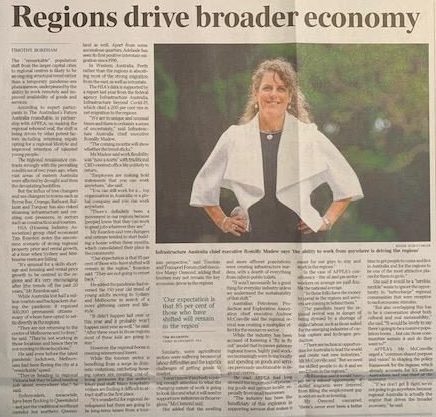Article by Timothy Boreham courtesy of the Australian

The “remarkable” population shift from the larger capital cities to regional centres is likely to be an ongoing structural trend rather than a temporary pandemic-era phenomenon, underpinned by the ability to work remotely and improved availability of goods and services.
According to expert participants in The Australian’s Future Australia roundtable, in partnership with APPEA, on making the regional rebound real, the shift is being driven by other potent factors including returning expats opting for a regional lifestyle and improved retention of talented young people.
The regional renaissance contrasts strongly with the prevailing conditions of two years ago, when vast areas of eastern Australia were affected by drought and then the devastating bushfires.
But the influx of tree changers and sea changers to towns such as Byron Bay, Orange, Bathurst, Ballarat and Torquay has also risked straining infrastructure and creating cost pressures, in sectors such as construction and tourism.
HIA (Housing Industry Association) group chief economist Tim Reardon notes the uncommon scenario of strong regional property price and rental growth, at a time when Sydney and Melbourne rents are falling.
“It’s unusual for a skills shortage and housing and rental price growth to be centred in the regions and it’s very encouraging after [the trends of] the past 20 years,” Mr Reardon said.
While Australia lost half a million tourists and backpackers during the pandemic it regained 300,000 permanent citizens – many of whom have opted to settle directly in the regions.
“They are not returning to the centre of Melbourne and Sydney,” he said. “They’re not working in those locations and hence they’re not moving to those locations.”
He said even before the latest pandemic lockdown, Melburnians had been fleeing the city at a “remarkable” speed.
“They’re heading to regional Victoria but they’re [also] heading just about everywhere else,” he said.
Sydneysiders, meanwhile, have been flocking to Queensland – not just the traditional northeast corridor but northern Queensland as well. Apart from some anomalous quarters, Adelaide has seen its first positive interstate migration since 1996.
In Western Australia, Perth rather than the regions is absorbing most of the strong migration from the east, as well as intrastate.
The HIA’s data is supported by a report last year from the federal agency Infrastructure Australia, Infrastructure beyond Covid-19, which cited a 200 per cent rise in net migration to the regions.
“We are in unique and unusual times and there is certainly a sense of uncertainty,” said Infrastructure Australia chief executive Romilly Madew.
“The coming months will show whether the trend sticks.”
Ms Madew said work flexibility was “now a norm” with traditional CBD-centred office life unlikely to return.
“Employers are making bold statements that you can work anywhere,” she said.
“You can still work for a … top organisation in Australia or a global company and you can work anywhere.
“There’s definitely been a movement in our regions because [people] know that they can work in great jobs wherever they are.”

Mr Reardon said tree changers and retirees tended to start building a house within three months, which consolidated their place in the community.
“Our expectation is that 85 per cent of those who have shifted will remain in the region,” Reardon said. “They are not going to revert back.”
He added the pandemic had reversed the 150-year old trend of young adults moving to Sydney and Melbourne in search of a more glittering career and lifestyle.
“It didn’t happen last year or this year and it probably won’t happen next year as well,” he said. “After three years in those regions most of these kids are going to stay.”
However, the regional boom is creating winners and losers.
While the tourism sector is benefiting from a surge in domestic visitations, ratcheting housing values are creating cost-of-living pressures for the sector’s lower paid staff. Many hospitality venues are finding it difficult to attract staff in the first place.
“It’s wonderful for regional development but there are going to be long-term issues from a tourism perspective,” said Tourism and Transport Forum chief executive Margy Osmond, adding that tourism may not remain the key economic driver in the regions.
Similarly, some agricultural sectors were suffering because of labour difficulties and the logistics challenges of getting goods to market.
“I don’t know if anybody is paying enough attention to what the changing nature of work is going to look like and what it will need to support new industries in those regions,” Ms Osmond said.
She added that the swelling and more affluent populations were creating infrastructure burdens, with a dearth of everything from cafes to public toilets.
“It won’t necessarily be a great thing for everyday industry unless we understand the sustainability of that shift.”
Australian Petroleum Production and Exploration Association chief executive Andrew McConville said the regional revival was creating a multiplier effect for the resources sector.
While the industry has been accused of fostering a “fly in fly out” model that bypasses gateway regional towns, highly paid workers increasingly were living locally and spending on goods and services previously unobtainable in regional centres.
He said APPEA had long stressed the importance of procuring goods and services locally, especially from small businesses.
“The industry has been the beneficiary of this explosion in supporting services that makes it easier for our guys to stay and work in the regions.”
In the case of APPEA’s constituency – the oil and gas sector – workers on average are paid double the national average.
“So these folks have the money to spend in the regions and services are coming in behind them.”
The panellists heard the regional revival was in danger of being stymied by a shortage of skilled labour, such as those suited for the emerging industries of carbon capture and hydrogen production.
“There are technical opportunities for Australia to lead the world and create vast new industries,” Mr McConville said. “But we need the skilled people to do it and we need them in the regions.”
Mr Reardon said it would “simply be a missed opportunity” if skilled migrants were deterred from filling the employment gap in sectors such as housing.
Ms Osmond concurred: “there’s never ever been a better time to get people to come and live in Australia and for the regions to be one of the most attractive places for them to go to.”
She said it would be a “terrible, terrible” waste to ignore the opportunity to “turbocharge” regional communities that were receptive to such economic stimulus.
“But also overlapping this has to be a conversation about both cultural and real sustainability,” she said. “It would be lovely to say there’s going to be a massive population boom … but can those communities sustain it and do they want to?”
APPEA’s Mr McConville urged a “common shared purpose and vision” in shaping the policy framework for the regions, which already accounts for 9.5 million Australians and one-third of the economy.
“If we don’t get it right we’re not going to go anywhere, because regional Australia is actually the engine that drives the broader economy,” he said.

